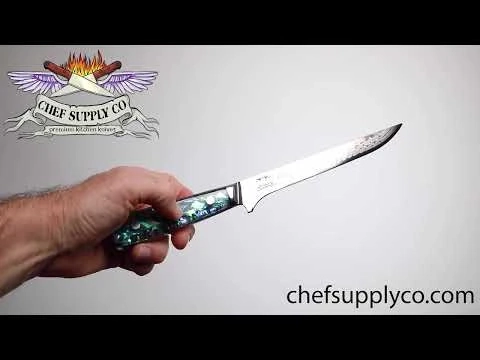Damascus steel has a distinctive wavy pattern that makes it a beautiful sight. Damascus knife was traditionally used to make the best swords. Accolades have been bestowed upon these blades due to the accuracy, tenacity, and reliability with which they perform. They are simple to spot because of the stunning undulating pattern that they leave on the steel blade.
Continue reading to find solutions to your most urgent problems about Damascus steel vegetable knives and other topics.
What Is a Damascus Knife?
Damascus steel is distinguished from other steels due to the distinctive wave patterns that run through it. Damascus steel is in high demand due to its impressive combination of properties, including toughness, malleability, and edge retention, in addition to its sleek and attractive appearance.
Damascus steel was first utilised in blade production by swordsmiths from Europe and Asia. The forging and folding of at least two distinct types of steel can result in the production of a higher quality and greater durability. The unusual pattern that is etched into the steel blade of the knife gives this particular type of steel a one-of-a-kind appearance.
These knives have always been very popular due to the exceptional quality they possess as well as their adaptability to a wide variety of different jobs.
The undulating surface pattern of this sturdy steel was produced by repeatedly heating and forging steel and iron strips that had been hammered together. This resulted in the appearance of waves. Damascus steel is used for more than just blades in today\'s world. In addition to vegetable knives, fixed-blade knives, and even swords, Damascus steel is increasingly being incorporated into other cutting tools.
Although the technique used to make Damascus knives dates back to antiquity, it has developed throughout history. Damascus knives made today are typically forged-welded using multiple types of steel or manufactured from a single type of steel that has been folded and refolded many times to create the Damascus pattern.
Incorporating one of these processes into the manufacturing of knife blades results in a one-of-a-kind pattern. You may get a Damascus knife in just about any design you can imagine. Damascus steel is used for various vegetable knives and blades, including those used for everyday tasks and outdoor activities.
How Damascus Got its Name?
Originating in Damascus, Syria, this steel has a rich history that inspired its moniker. Some claim that two Islamic philosophers named Al-Kindi and Al-Biruni (who lived between 800 and 773 CE) described swords and steel based on their appearance, the location where they were forged or created, and the name of the blacksmith who did it. This would explain the origin of the name "Damascus Steelgenesis." In both of their writings, the term "damascene" or "Damascus" was employed to refer to the swords.
But these aren\'t the only myths surrounding Damascus blades\' birth.
Over a thousand years ago, the blacksmiths of Damascus were regarded as the greatest in the world for the unique ways in which they produced steel. They said this method produced the finest, most powerful blades ever seen.
They used a specific process, which included repeatedly heating and bending the steel, to make the blade more ductile and robust. The hammering and pounding process gave the product a one-of-a-kind look. The intricate swirl pattern on the knife blades was reminiscent of crashing waves on the shore.
The aesthetics of these blade knives were praised highly, and many even said they performed miraculously. It was also said that the "Damascus" swords could keep their edge incredibly long and were remarkably resistant to chipping and damage.
Instructions For Damascus Steel Maintenance
Damascus steel vegetable knives take many hours to craft, so treating them with the utmost respect and care is only fitting. To ensure that a masterpiece is preserved for future generations, care must be taken to prevent damage. Damascus knife requires special care to preserve their lustre and attractiveness over time.
It\'s important to know that the alloy used in many hand-forged Damascus blades consists of chromium and high-carbon steel. A blade forged from such steel is prone to rust if not cared for correctly. By keeping them in pristine condition, collectors should avoid having their blades rust or become discoloured.
After drying, the blade of a Damascus steel knife should be lubricated with a special wax to prevent rust. As long as the blade is protected from rust, the steel\'s pattern will seem as beautiful and vibrant as the day it was hand forged.
The blade\'s appearance may also be modified by using chemicals and materials. You may remove the etched oxidation that exposes the blade\'s pattern with little elbow grease or abrasive cloth.
A blade\'s durability is significantly affected by how you keep it. When not in use, your Damascus knife should be stored in a dry, indoor location protected from humidity and temperature swings. These knives need to be stored in a hard or soft case.
0



